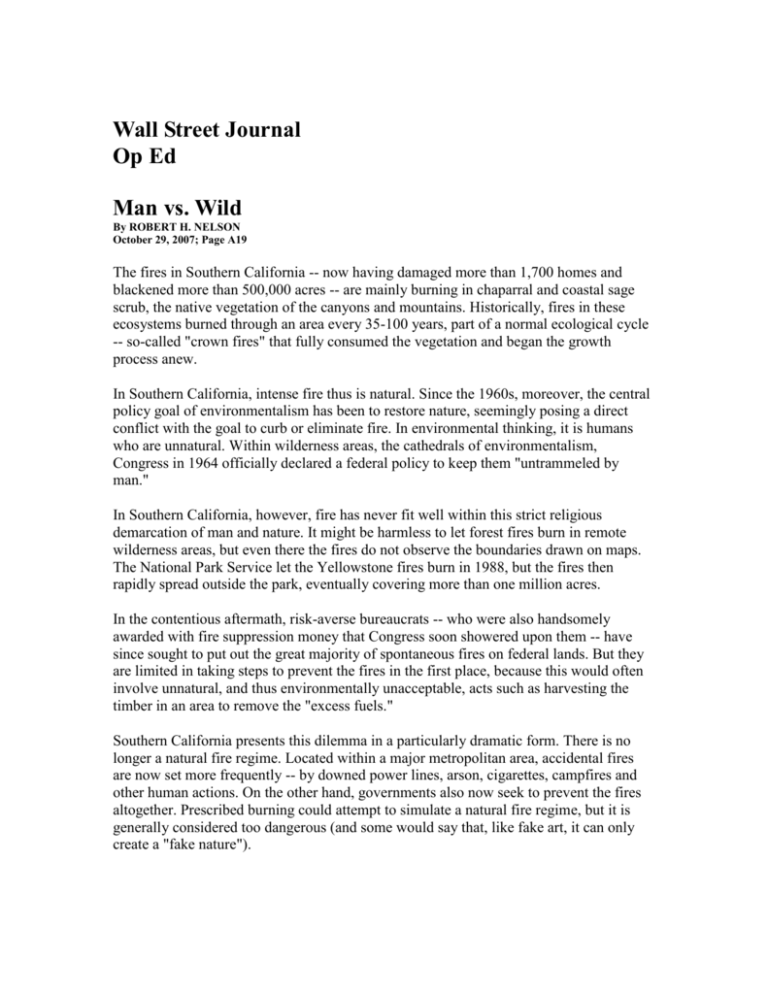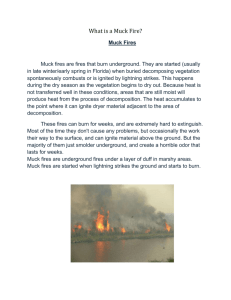Man vs. Wild - School of Public Policy
advertisement

Wall Street Journal Op Ed Man vs. Wild By ROBERT H. NELSON October 29, 2007; Page A19 The fires in Southern California -- now having damaged more than 1,700 homes and blackened more than 500,000 acres -- are mainly burning in chaparral and coastal sage scrub, the native vegetation of the canyons and mountains. Historically, fires in these ecosystems burned through an area every 35-100 years, part of a normal ecological cycle -- so-called "crown fires" that fully consumed the vegetation and began the growth process anew. In Southern California, intense fire thus is natural. Since the 1960s, moreover, the central policy goal of environmentalism has been to restore nature, seemingly posing a direct conflict with the goal to curb or eliminate fire. In environmental thinking, it is humans who are unnatural. Within wilderness areas, the cathedrals of environmentalism, Congress in 1964 officially declared a federal policy to keep them "untrammeled by man." In Southern California, however, fire has never fit well within this strict religious demarcation of man and nature. It might be harmless to let forest fires burn in remote wilderness areas, but even there the fires do not observe the boundaries drawn on maps. The National Park Service let the Yellowstone fires burn in 1988, but the fires then rapidly spread outside the park, eventually covering more than one million acres. In the contentious aftermath, risk-averse bureaucrats -- who were also handsomely awarded with fire suppression money that Congress soon showered upon them -- have since sought to put out the great majority of spontaneous fires on federal lands. But they are limited in taking steps to prevent the fires in the first place, because this would often involve unnatural, and thus environmentally unacceptable, acts such as harvesting the timber in an area to remove the "excess fuels." Southern California presents this dilemma in a particularly dramatic form. There is no longer a natural fire regime. Located within a major metropolitan area, accidental fires are now set more frequently -- by downed power lines, arson, cigarettes, campfires and other human actions. On the other hand, governments also now seek to prevent the fires altogether. Prescribed burning could attempt to simulate a natural fire regime, but it is generally considered too dangerous (and some would say that, like fake art, it can only create a "fake nature"). Given all the other wide human impacts, it might make sense simply to declare that the entire Los Angeles/San Diego area is unnatural. Instead, the residents want to have it both ways -- to have fire protection and to believe they live in a natural environmental setting. The large areas of adjoining and intermingled national forests are managed by the U.S. Forest Service to be natural ecosystems. Owing to 1990s protections for the gnatcatcher, a threatened bird species native to Southern California, and many other kinds of development restrictions, other large areas have been set aside to protect what are ostensibly places to experience the inspiration of wild nature -- all this amid 20 million people. Environmental theology offers natural and unnatural as the new synonyms for good and evil. Few people want to make a deliberate choice for evil. Fire in Southern California is natural. Yet fire burns thousands of homes every few years -- an evil in many eyes. It is all very confusing. The idea of nature has long been a central element in Western religion. In the theology of John Calvin, there were two ways of knowing about God -- reading the Bible and observing the Book of Nature. Nature was seen as a mirror of the mind of God; the Creation was God's artwork by which He instructed human beings. As Calvin wrote in "Institutes of the Christian Religion," "the knowledge of God [is] sown in their minds out of the wonderful workmanship of nature." In the 18th century, Jonathan Edwards -- the foremost Calvinist theologian of the time in America -- believed that the "created world was the very language of God." When Ralph Waldo Emerson, Henry David Thoreau and other New England transcendentalists looked to nature for religious inspiration, they were drawing on this Massachusetts Calvinist heritage. John Muir, the founder of the Sierra Club in 1892, was a disciple of Emerson who moved west to learn about God in the mountains of California -- places he saw as "holy as Sinai." In the late 20th century, environmentalists would discard the Christian vocabulary but otherwise still experience the same awe and reverence in the presence of nature. Combined with a rejection of high consumption and other ascetic ideals, environmentalism would proclaim to be a new "Calvinism minus God." When Calvin, Edwards and Emerson preached, they could believe that they were actually encountering the Creation that had been little altered since God made it, then believed to have occurred 6,000 years ago. Darwin and modern geology, however, have changed all that. In Southern California, it is a Disneyland fantasy to believe that any part of the natural world is little altered from even a few hundred years ago, or that any areas could be restored to a truly wild condition. America's leading environmental historian, William Cronon, declares that Orange County is a new "form of nature: nature as virtual reality." Recognizing the deep tensions in environmental thinking, Mr. Cronon now recommends that he and his fellow environmentalists abandon the "unexamined, sometimes contradictory, assumptions at the core of our own beliefs" relating to the moral value of wilderness and other areas previously characterized as natural. After the 2003 fires, Gov. Arnold Schwarzenegger created a blue-ribbon state commission to set future fire policy. Seeing the fire carnage now revisiting Southern California in 2007, the former head of the commission, William Campbell, notes that "we still haven't resolved the [core] battle between the saving of lives and property versus the environmental issues." Tighter zoning to exclude homes from the most dangerous areas, much better fireproofing of homes and other structures, more spending on fire departments, and other practical measures can significantly reduce the fire risks. Finally resolving the fire problem in Southern California, however, has more to do with rethinking the relationship of man and nature there -- a subject of ancient and still deep religious significance. Rather than restoring wild nature, Southern Californians would do better to think of the natural world around them as a large and wonderful set of gardens -- many Central Parks on a much grander scale -- designed by human beings for human aesthetic and other "anthropocentric" purposes, including the tight limitation of fire risks. Mr. Nelson, a professor of environmental policy in the School of Public Policy at the University of Maryland and an affiliated scholar with the Mercatus Center, is the author of "A Burning Issue: A Case for Abolishing the U.S. Forest Service" (Rowman & Littlefield, 2000).




